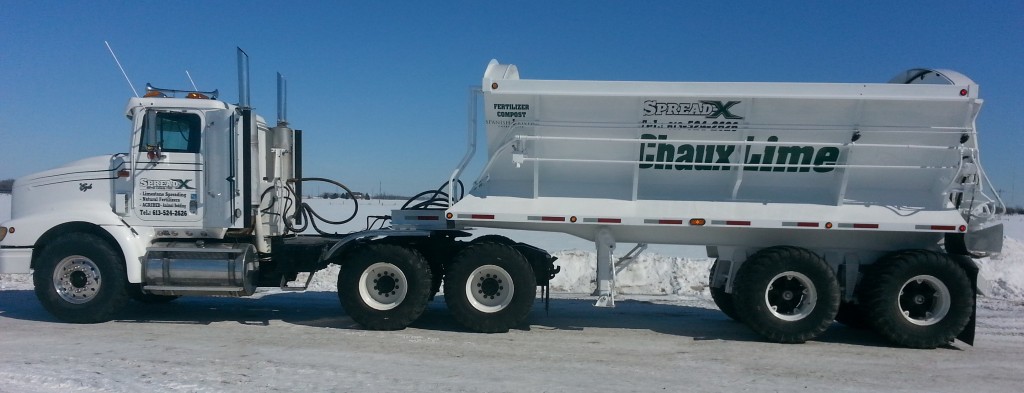The Spread-X Method
Good soil is all about sustainable soil. If the soil isn’t healthy, then nothing is. And if we can’t sustain the health of the soil, we have a serious problem.
As we move towards sustainability, all kinds of great things start to happen:
- Healthier Crops — As the soil improves, so do our crops. I remember my dad saying to me, “Marc, It’s all connected. What we do to the soil, it does to the crops.” It’s all connected.
- Better Yields — Healthier soil and stronger crops lead to better yields. This means we have to make smart choices and investments that will sustain the soil for the long-term while improving it’s health in the short term.
- Strong, Resilient Farms — Few things make us happier than seeing a farm that is thriving. Farmers who are making great decisions that are making every part of their farm and their business stronger. These are the farms that last. These are the farms that we pass to our children with pride.
We’re honoured to serve our clients. To be part of your farm and to help you as you build a strong, resilient business. Here’s how we approach it.
Relationships
We said it before, but it’s worth repeating: everything is connected — and that includes us.
A sustainable approach to healthy soil is all about relationships. It’s about taking the time to really know what you need and what your soil needs. It’s about getting to know what’s important to your farm right now. It’s about understanding how each other works so we can work together.
For a long time, conversations about soil health have been more about price. Price matters, but it can’t be the entire conversation. The days of making short-term decisions based on price hoping that next year will be better just are almost gone. We all know this doesn’t work. It leads to depleted fields and soil that is empty.
Today we’re seeing more serious conversations — more sophisticated conversations — that look at smart short-term actions that build on each other to make powerful long-term changes to our fields and our farms.
Those conversations are powerful, and they rely on honest, genuine relationships. There’s no other way.
Education
New approaches to improving soil health are emerging all the time. It’s exciting! And sometimes it’s daunting. There is so much information emerging that it’s essential that we continue to learn. And I don’t just mean us — I mean all of us!
Our depth of understanding of what it takes to create a truly sustainable approach to soil health continues to grow. And each of us has a responsibility to continue to look at how these emerging approaches can be applied.
But we’re also relearning many of the methods that worked 100 years ago and more, and finding new ways to apply them in our current context. That means we keep changing and testing and experimenting together to find powerful, natural ways to improve the health of our soil.
Innovation
Learning is key, but applying it is everything. Innovation is at the heart of what we do.
Take a careful look and you’l see how we innovate in just about everything we do. We’re constantly trying to look at things in new ways to see how we can help your soil get healthier. We’ve changed our machinery, our vehicles and our methods of spreading so that they work the best possible way for your soil.
Spreaders like no other
Here’s an example. Our one-of-a-kind Direct Truck is specially built to go from the road directly onto the field. It can haul and spread up to 25 tonnes of lime, compost and granulated products. There is no longer a need to dump lime in the field. This eliminates the compaction caused by the loader and transport vehicle, and the need to clean the dumpsite. It’s a faster, more efficient process, having the benefits of a flotation truck, without the compaction and mess of transportation, dumping and loading on site.
And this isn’t just about using technology to solve every problem. Sometimes technology can get in the way and we need to make the right, pragmatic choices about what to do. For example, it’s common in the industry to use GPS when spreading on fields in order to adjust the distribution. But it’s not always the right thing to do. Something as common as a windy day can change the equation. We need to be flexible to the conditions and use the right tools for the job.
GPS: Sometimes we do, sometimes we don’t
Like many aspects of farming, there are times when we use the latest in technology. But like other aspects of farming, there are times when even the most advanced technology is no substitute for the abilities and judgement of a skilled, experienced operator.
GPS will help us get to your field, but spreading material strictly guided by a GPS screen doesn’t always work. A GPS doesn’t have the ability to regulate for wind speed, humidity and moisture, or the topography and nuances of the land.
Often manual adjustments need to be made that are outside of the computer’s capabilities. Only experienced hands and eyes can make the correct adjustments.
While the technology is there to assist us, people still make better farmers than computers.
We have also found innovative sources of organic material and new ways to combine them and distribute them. We’ve ensured that everything we use — absolutely everything — is naturally sourced.

